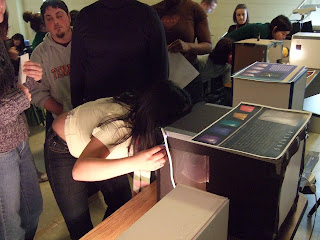
Thursday, April 3, 2008
Thursday, March 6, 2008
Sunday, March 2, 2008
On daylight-saving time and circadian rhythms
Check out this interesting article which discusses the impact of daylight-saving time on your body's internal clock.
Also this article on 'clock genes' and circadian rhythms by theUniversity of Utah Genetic Science Learning Center.
Also this article on 'clock genes' and circadian rhythms by the
Wednesday, February 20, 2008
Total Lunar Eclipse
Did you see the lunar eclipse starting 8:43pm on February 28, 2008? http://blog.wired.com/wiredscience/2008/02/perfect-viewing.html
Lights at Night Are Linked to Breast Cancer
Did you know that a recent finding adds credence to the hypothesis that exposure to too much light at night can raise the risk of breast cancer by interfering with the brain's production of a tumor-suppressing hormone. Read more at :
http://www.washingtonpost.com/wp-dyn/content/article/2008/02/19/AR2008021902398.html?hpid=topnews
http://www.washingtonpost.com/wp-dyn/content/article/2008/02/19/AR2008021902398.html?hpid=topnews
Monday, January 28, 2008
Medical Myth
Did you know that common perception that reading in dim light ruins your eyesight is a medical myth!
Sketch Series One
We hope that you have started your Sketch Series One:
Choose an interior place that you will record through the whole semester. Observe how light changes throughout the day. Observe how light changes through the seasons from winter to spring to summer. Note how the space ‘feels’ or ‘works’. Sketch your observations; study the change in light, shadows, color, texture, activities in this space.
Document this place once every two weeks (every week is better!) close to the following days from the same viewpoint/s: January 19, February 2, February 16, March 1, March 15, March 29, April 12, April 26.
Light Quotes
Colors are the deeds and sufferings of light: Goethe
We are all light-eaters! : James Turrell
Light is not so much something that reveals, as it is itself the revelation: James Turrell
Use the light that is within you to regain your natural clearness of sight: Lao-Tzu
We are all light-eaters! : James Turrell
Light is not so much something that reveals, as it is itself the revelation: James Turrell
Use the light that is within you to regain your natural clearness of sight: Lao-Tzu
Wednesday, January 16, 2008
Light Model
After the visit to the Natural Science Center and from your understanding of light so far, design an interior space 12’x12’x12’ in volume.
Determine the functional use of this space best suited to the lighting quality. Make a physical model of this space (at least 1’=1” scale) to be exhibited in the Studio Arts Building. This model should allow one to observe/ inspect/ examine the lighting effects inside the model.
Post process images from your light model as you start working on it.
Determine the functional use of this space best suited to the lighting quality. Make a physical model of this space (at least 1’=1” scale) to be exhibited in the Studio Arts Building. This model should allow one to observe/ inspect/ examine the lighting effects inside the model.
Post process images from your light model as you start working on it.
Interior Lighting Design
Light Revealing Experience:
Think of ways light has shaped your experience of a space. Select an image that moved/ inspired/ intrigued/ awed you.
(The selections can be viewed on the links to your blogs on the right)
Think of ways light has shaped your experience of a space. Select an image that moved/ inspired/ intrigued/ awed you.
(The selections can be viewed on the links to your blogs on the right)
Subscribe to:
Comments (Atom)









